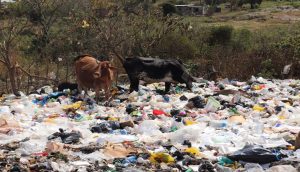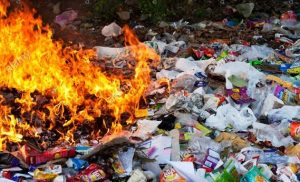
Plastic pollution is the accumulation of plastic objects and particles (e.g. plastic bottles, bags and microbeads) in the Earth’s environment this adversely affects wildlife, wildlife habitat, and humans. Plastics are inexpensive and durable making them very adaptable for different uses; as a result humans produce a lot of plastic. However, the chemical structure of most plastics renders them resistant to many natural processes of degradation and as a result they are slow to decompose. Together, these two factors allow large volumes of plastic to enter the environment as mismanaged waste and for it to persist in the ecosystem. The distribution of plastic debris is highly variable as a result of certain factors such as wind and ocean currents, coastline geography, urban areas, and trade routes. Human population in certain areas also plays a large role in this.
Plastics are more likely to be found in enclosed regions such as Botswana. It serves as a means of distribution of organisms to remote coasts that are not their native environments. This could potentially increase the variability and dispersal of organisms in specific areas that are less biologically diverse. Plastics can also be used as vectors for chemical contaminants such as persistent organic pollutants and heavy metals. In 2019 a new report “Plastic and Climate” was published. According to the report, in 2019, production and incineration of plastic will contribute greenhouse gases in the equivalent of 850 million tons of carbon dioxide (CO2) to the atmosphere. In current trend, annual emissions from these sources will grow to 1.34 billion tons by 2030. By 2050 plastic could emit 56 billion tons of greenhouse gas emissions, as much as 14 percent of the earth’s remaining carbon budget. By 2100 it will emit 260 billion tons, more than half of the carbon budget. Those are emission from production, transportation, incineration, but there are also releases of methane and effects on phytoplankton.

Plastic pollution on land poses a threat to the plants and animals – including humans who are based on the land. Estimates of the amount of plastic concentration on land are between four and twenty-three times that of the ocean. The amount of plastic poised on the land is greater and more concentrated than that in the water. Mismanaged plastic waste ranges from 60 percent in East Asia and Pacific to one percent in North America. The percentage of mismanaged plastic waste reaching the ocean annually and thus becoming plastic marine debris is between one third and one half the total mismanaged waste for that year. Chlorinated plastic can release harmful chemicals into the surrounding soil, which can then seep into groundwater or other surrounding water sources and also the ecosystem of the world. This can cause serious harm to the species that drink the water. A 2017 study found that 83% of tap water samples taken around the world contained plastic pollutants.
This was the first study to focus on global drinking water pollution with plastics, and showed that with a contamination rate of 94%, tap water in the United States was the most polluted, followed by Lebanon and India. European countries such as the United Kingdom, Germany and France had the lowest contamination rate, though still as high as 72%. This means that people may be ingesting between 3,000 and 4,000 micro-particles of plastic from tap water per year. The analysis found particles of more than 2.5 microns in size, which is 2500 times bigger than a nanometer. It is currently unclear if this contamination is affecting human health, but if the water is also found to contain nanoparticle pollutants, there could be adverse impacts on human well-being, according to scientists associated with the study. However, plastic tap water pollution remains under-studied, as are the links of how pollution transfers between humans, air, water, and soil. With an ongoing war against planet earth degradation, we at Green Land Environmental Holdings believe that less can be so much more, the size of the gesture does not matter. By adapting to the use of non-woven bags and saying NO PLASTIC, one gives the human race a fighting chance to win our planet back.
